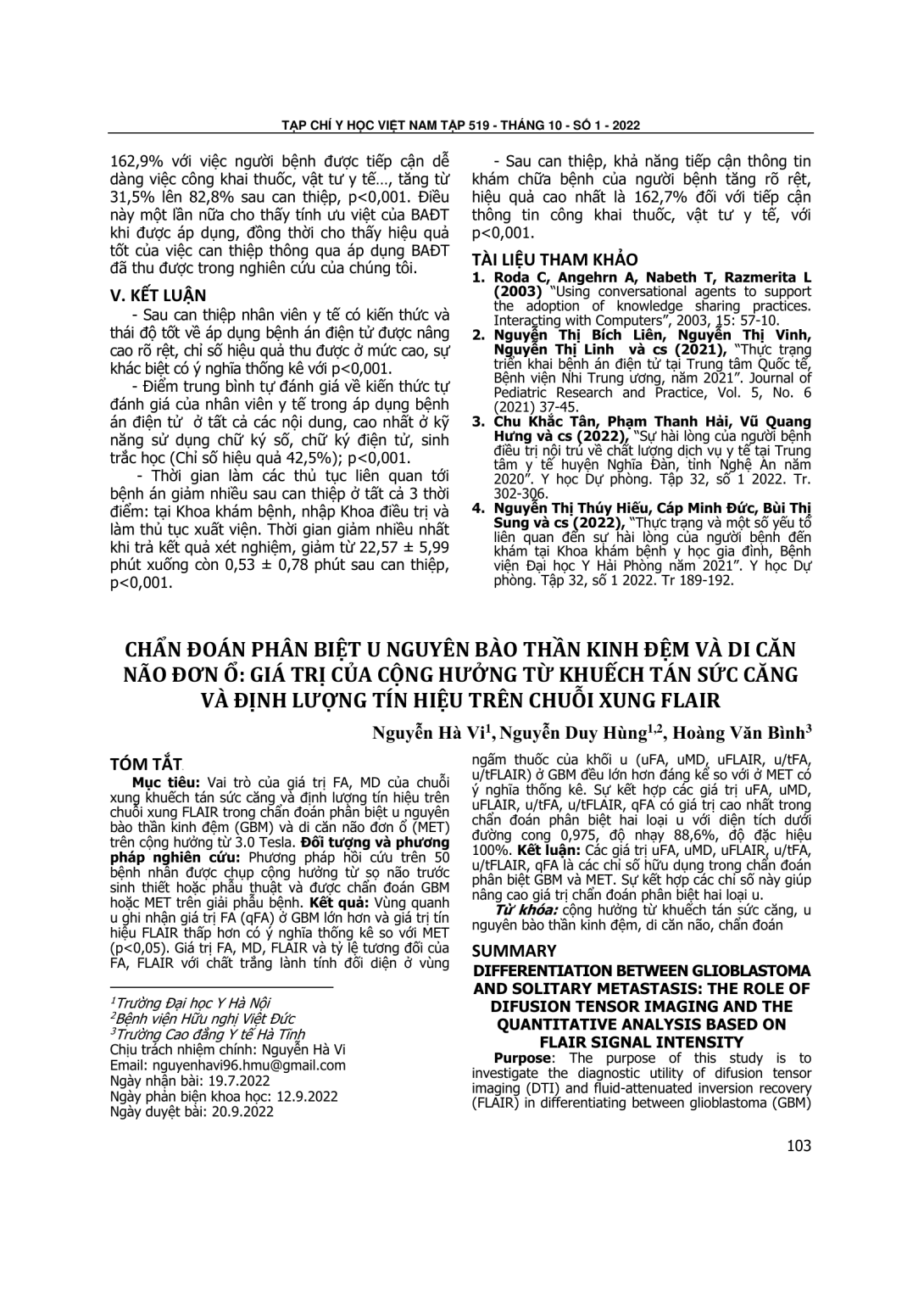
Vai trò của giá trị FA, MD của chuỗi xung khuếch tán sức căng và định lượng tín hiệu trên chuỗi xung FLAIR trong chẩn đoán phân biệt u nguyên bào thần kinh đệm (GBM) và di căn não đơn ổ (MET) trên cộng hưởng từ 3.0 Tesla. Đối tượng và phương pháp nghiên cứu: Phương pháp hồi cứu trên 50 bệnh nhân được chụp cộng hưởng từ sọ não trước sinh thiết hoặc phẫu thuật và được chẩn đoán GBM hoặc MET trên giải phẫu bệnh. Kết quả: Vùng quanh u ghi nhận giá trị FA (qFA) ở GBM lớn hơn và giá trị tín hiệu FLAIR thấp hơn có ý nghĩa thống kê so với MET (p<0,05). Giá trị FA, MD, FLAIR và tỷ lệ tương đối của FA, FLAIR với chất trắng lành tính đối diện ở vùng ngấm thuốc của khối u (uFA, uMD, uFLAIR, u/tFA, u/tFLAIR) ở GBM đều lớn hơn đáng kể so với ở MET có ý nghĩa thống kê. Sự kết hợp các giá trị uFA, uMD, uFLAIR, u/tFA, u/tFLAIR, qFA có giá trị cao nhất trong chẩn đoán phân biệt hai loại u với diện tích dưới đường cong 0,975, độ nhạy 88,6%, độ đặc hiệu 100%. Kết luận: Các giá trị uFA, uMD, uFLAIR, u/tFA, u/tFLAIR, qFA là các chỉ số hữu dụng trong chẩn đoán phân biệt GBM và MET. Sự kết hợp các chỉ số này giúp nâng cao giá trị chẩn đoán phân biệt hai loại u.
The purpose of this study is to investigate the diagnostic utility of difusion tensor imaging (DTI) and fluid-attenuated inversion recovery (FLAIR) in differentiating between glioblastoma (GBM) and solitary metastasis (MET) by analyzing fractional anisotropy (FA), mean diffusivity (MD) value of DTI and FLAIR signal intensity. Materials and methods: Fifty patients with GBM and MET who underwent conventional and DTI on 3 Tesla MRI, surgery or biopsy and had histopathologic reports at the Viet Duc Hospital were retrospectively reviewed. Three regions of interest (ROI) were placed in the enhancement region of the tumor, the peritumoral edema, and the opposite normal white matter on FA map, MD map and FLAIR in order to measure FA, MD value and signal intensity. The diagnostic value of the significant difference parameters between two entities was analyzed by using the receiver operating characteristic (ROC) curve. Results: In the peritumoral region, FA value (qFA) of GBM was significantly greater but the FLAIR signal (qFLAIR) was lower than that of MET (p<0,05). The FA, MD values, FLAIR signal in the enhancing region (uFA, uMD, uFLAIR) and the ratio of FA value between the enhancing region to opposite normal white matter (u/tFA) in GBM were both significantly greater than those of MET (p<0,05). Combining the uFA, uMD, uFLAIR, u/tFA, u/tFLAIR, qFA values provided the highest area under the curve (AUC) of 0,975, the sensitivity 88,6% and specificity 100% in distinguishing GBM and MET. Conclusions: The uFA, uMD, uFLAIR, u/tFA, u/tFLAIR, qFA are useful parameters for differentiation between GBM and MET. The combination of those values may increase the diagnostic performance.
- Đăng nhập để gửi ý kiến
